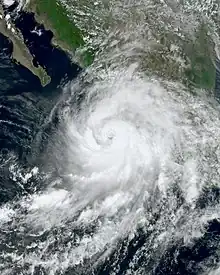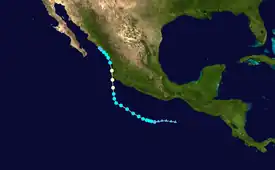Hurricane Nora (2021)
Hurricane Nora was a large tropical cyclone that made landfall in southern Mexico, and later went to affect Baja California. The fourteenth named storm and fifth hurricane of the 2021 Pacific hurricane season, the system was first monitored by the National Hurricane Center (NHC) as an area of low pressure near the coast of Mexico. It intensified into Tropical Depression Fourteen-E, but the depression struggled to develop as a result of wind shear. It further intensified to a tropical storm and was named Nora as it tracked west-northwest. It peaked as a Category 1 hurricane with winds of 85 miles per hour (140 km/h) on August 28, before grazing the Mexico coastline and making landfall two separate times, dissipating on August 30. According to the National Hurricane Center's Tropical Cyclone Report, three direct deaths occurred as a result of Nora.
 Hurricane Nora at peak intensity on August 28 | |
| Meteorological history | |
|---|---|
| Formed | August 24, 2021 |
| Dissipated | August 30, 2021 |
| Category 1 hurricane | |
| 1-minute sustained (SSHWS/NWS) | |
| Highest winds | 85 mph (140 km/h) |
| Lowest pressure | 976 mbar (hPa); 28.82 inHg |
| Overall effects | |
| Fatalities | 3 total |
| Damage | $125 million |
| Areas affected | Western Mexico |
| IBTrACS / [1] | |
Part of the 2021 Pacific hurricane season | |
Meteorological history

Tropical storm (39–73 mph, 63–118 km/h)
Category 1 (74–95 mph, 119–153 km/h)
Category 2 (96–110 mph, 154–177 km/h)
Category 3 (111–129 mph, 178–208 km/h)
Category 4 (130–156 mph, 209–251 km/h)
Category 5 (≥157 mph, ≥252 km/h)
Unknown
Hurricane Nora originated from a tropical wave that emerged off Africa on August 13. It quickly moved westward over next few days, and at 15:00 UTC of August 19 as it moved into the Caribbean Sea,[1] the National Hurricane Center (NHC) first indicated the possible development of an area of low pressure to the south of the coast of Mexico, giving it a 20% chance of forming in the next five days.[2] The NHC further raised the system's probability of intensification occurrence to "medium"[3] and then to "high" on the next day,[4] and by August 24, a broad area of low pressure formed over warm sea surface temperatures.[1] Scatterometer data on August 25 reported that a well-defined but small area of circulation inside the low-pressure area and was producing near tropical storm-force winds,[5] with the NHC designating the disturbance as a tropical depression at 12:00 UTC of August 25. 6 hours later at 18:00 UTC, scatterometer data prompted the system's upgrade to a tropical storm, gaining the name Nora.[1] Nora continued westward over a favorable environment for development. It became disorganized that night, with its convection being displaced to the northwest due to wind shear, as evidenced by satellite and microwave imageries.[6]
Nora began to turn slightly northwest by the next day,[7] with a decline in wind shear allowing the storm to strengthen and develop convection on August 27. Nora then began to turn north-northwestward, with it forming an eye on August 28.[1] Its developing inner core became wrapped by deep convection with cold cloud tops,[8] and by 12:00 UTC, Nora was upgraded to a Category 1 hurricane. At 15:00 UTC, microwave imagery showed that it had a closed eyewall.[1]
Preparations

On August 30, the National Hurricane Center issued a hurricane warning from San Blas, Nayarit to Altata, Sinaloa. Hurricane watches and tropical storm warnings were issued in Altata to Topolobampo. Tropical storm watches were put in place from Cabo San Lucas and La Paz, Baja California Sur.[9]
The Servicio Meteorológico Nacional called for extreme precaution in the states of Colima, Michoacán, Guerrero, Oaxaca, and Jalisco.[10] It was recommended for locals to get away from beaches and other low-lying areas that could be affected by high waves, avoid parking in wave-prone areas, and to go to safe areas defined by authorities.[11] People who lived in areas threatened by Nora's flooding were monitored to give them the resources needed in the aftermath if they were affected.[12]
Impact
Heavy rainfall occurred across the western coast of Mexico, with 300 mm (12 in) being recorded across coastal regions in Guerrero, Colima, Michoacán, Jalisco, Nayarit, and Sinaloa. A peak rainfall total of 523 mm (20.6 in) occurred at Melchor Ocampo, Michoacán. A total of 444.8 mm (17.51 in) of rain registered at José María Morelos y Pavón, Michoacán, and 421.2 mm (16.58 in) was recorded at the Observatorio de Mazatlán, Sinaloa. The storm left impacts in 44 municipalities and approximately 355,000 people without power. 30 rivers in Mexico had overflowed due to the flooding.[13][14] Overall, three people were killed, and damage was estimated at US$125 million.[15][16]
In Chiapas, the body of a member of the Mexican Air Force was later found after he had been swept away by the strong currents.[17] Severe damage occurred across Jalisco. In Puerto Vallarta, a bridge collapsed into the Cuale River, and buildings near the river were damaged. Overflowing rivers, falling trees, fallen power lines, and landslides prompted the closure of the Guadalajara–Colima highway and the El Grullo-Ciudad Guzmán state highway. At the latter, a landslide dropped a person into a 120 m (390 ft) deep ravine and injured two others. A construction worker also died in a landslide on a road connecting Ciudad Guzmán and San Gabriel. The Arroyo El Pedregal river overflowed in Melaque, Cihuatlán municipality, damaging at least 500 homes. Two people were reported missing in the municipality. The Bahía de Banderas was evacuated as the level of the Ameca River continued to increase, with a temporary shelter being established in San Vicente. Power outages were reported in the former city as a result of downed electrical lines and poles. A child also died in the collapse of a hotel, which was associated with Nora, and another person was reported to be missing.[14] On September 5, a fisherman's body was found at a beach in Marquelia, Guerrero.[18] In Ciudad Guzmán, flooding from the Los Volcanes river inundated some urban areas.[19][20] The Government of Michoacán declared states of emergency for the municipalities of Arteaga, Lázaro Cárdenas, Tumbiscatio, Aquila, and Coahuayana in the wake of Nora. A road leading to Uruapan also collapsed and was closed by authorities. Landslides also damaged a highway between Uruapan and Lombardí. Mudslides made a road leading to the city of Morelia impassable. In the Port of Lázaro Cárdenas, the Acalpican river overflowed, causing flooding on August 29. There also were reports of other floods, landslides, and uprooted trees in Michoacán. In the municipal seat of Arteaga, the Toscano river flooded, which caused several cars to be dragged by the flow. Multiple homes and businesses were damaged.[11][17]
Aftermath
Federal, state, and municipal authorities worked on coastal roads to help restore communication damage caused by downed lines and trees.[11]
See also
References
- Philippe Papin (March 4, 2022). Tropical Cyclone Report: Hurricane Nora (PDF) (Report). Miami, Florida: National Hurricane Center. Retrieved June 14, 2022.
- Daniel Brown (August 19, 2021). "Five-Day Graphical Tropical Weather Outlook". Miami, Florida: National Hurricane Center. Retrieved August 27, 2021.
- Brad Reinhart; John Cangialosi (August 20, 2021). "Five-Day Graphical Tropical Weather Outlook". Miami, Florida: National Hurricane Center. Retrieved August 27, 2021.
- Dave Roberts (August 22, 2021). "Five-Day Graphical Tropical Weather Outlook". Miami, Florida: National Hurricane Center. Retrieved June 21, 2022.
- Robbie Berg (August 25, 2021). "Tropical Depression Fourteen-E Discussion Number 1". Miami, Florida: National Hurricane Center. Retrieved August 27, 2021.
- Brad Reinhart; Richard Pasch (August 25, 2021). "Tropical Depression Fourteen-E Discussion Number 2". Miami, Florida: National Hurricane Center. Retrieved August 27, 2021.
- Robbie Berg (August 26, 2021). "Tropical Storm Nora Discussion Number 4". Miami, Florida: National Hurricane Center. Retrieved August 27, 2021.
- Philippe Papin; Jack Beven (August 28, 2021). "Hurricane Nora Discussion Number 11". Miami, Florida: National Hurricane Center. Retrieved August 28, 2021.
- "El huracán Nora se localiza a 15 km de las costas de El Roblito, Nayarit". Vértigo Político (in Spanish). 2021-08-30. Retrieved 2021-09-05.
- "Nora deja lluvias fuertes en el Pacífico mexicano a punto de ser huracán". www.efe.com (in Spanish). Retrieved 2021-09-06.
- "Atiende PC estatal afectaciones tras el paso de "Nora" – Sistema Michoacano de Radio y Televisión" (in Spanish). 29 August 2021. Retrieved 2021-09-06.
- "Abren PC Coahuayana Refugio para Damnificados por huracán Nora - Quadratín". Quadratín Colima (in Spanish). 2021-08-28. Retrieved 2021-09-06.
- Precipitación acumulada (mm) del 25 al 30 de agosto de 2021 por el huracán Nora (Map) (in Spanish). Conagua. Archived from the original on 4 September 2021. Retrieved 6 September 2021.
- "Hurricane "Nora" causes damage in 44 municipalities in 6 Mexican states". The Yucatan Times. August 31, 2021. Retrieved September 11, 2021.
- Global Catastrophe Recap August 2021 (PDF) (Report). Aon Benfield. September 9, 2021. Retrieved September 10, 2021.
- Global Catastrophe Recap September 2021 (PDF) (Report). Aon Benfield. October 12, 2021. Retrieved October 12, 2021.
- "Remanentes de Nora dejan bajo el agua a Michoacán" [Remnants of Nora leave Michoacán underwater]. 24 Horas Mexico (in Mexican Spanish). September 1, 2021. Retrieved September 7, 2021.
- "Hallan cuerpo de pescador desaparecido en Acapulco; faltan 5 tras paso del huracán Nora".
- Santos, Javier; Navarro, Myriam (29 August 2021). "Huracán 'Nora' deja dos desaparecidos y casas dañadas en Jalisco". La Jornada (in Spanish). Retrieved 6 September 2021.
- "El Hurácan Nora cobró dos vidas a su paso por Jalisco" [Hurricane Nora claimed two lives as it passed through Jalisco]. La Voz del Sur de Jalisco (in Mexican Spanish). August 29, 2021. Retrieved September 7, 2021.
External links
- The NHC's Advisory archive on Hurricane Nora
